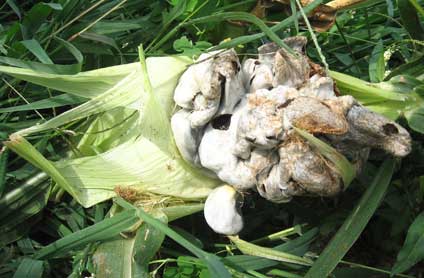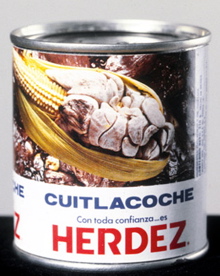Huitlacoche
For a gardener, Ustilago maydis can certainly be a little scary, especially if you don’t know what it is. Imagine going out to your sweet corn patch and finding this! No wonder it has been called “Devil’s corn.” But once you learn a little more about this smut, it becomes an intriguing, and maybe even desirable addition to the garden.

In the fungal phylum Basidiomycota, smuts are distant relatives of true mushrooms. They are named for the masses of black dusty spores they produce, which resemble smut, or if you’re not into archaic language, soot. There are more than 1,000 species of smut and they all parasitize flowering plants, infecting more than 75 families.
Most U.S. corn farmers consider this fungus a disease. Infestations are more common after rains preceded by dry, hot summers. Infection causes insufficient chlorophyll production, reduced growth and most disturbingly, the appearance of those nasty looking spore-filled galls. These things could have come right out of a bad science fiction movie. Each one is actually a kernel of corn that has been co-opted by the fungus, kind of like how a virus takes over its host’s cells and uses them to produce more virus. Crop losses are less than 5 percent. U. maydis‘ biggest impact on sweet corn farmers is that it prevents mechanical harvesting, because if one infected ear gets into the harvester it can cover all the healthy ears with an unappealing black mess. There are no pesticides approved for treating seeds or plants, but some corn varieties are more resistant than others (Silver Queen is highly susceptible, for example, whereas Silver King is more resistant).
In Mexico, however, farmers smile when they see a smut infestation because the fungus, considered a delicacy, fetches a higher price than the corn. In an attempt to gain mass acceptance north of the border, foodies have re-branded it the “maize mushroom,” though it’s not a true mushroom. “Mexican truffle” might seem more accurate, because truffles aren’t true mushrooms either, but they belong to a completely different phylum, the Ascomycota. The ancient Aztecs, who believed it possessed mystical, even aphrodisiac powers, simply called it huitlacoche (wee-tlah-KOH-cheh) variously translated as “raven excrement” or just plain “black shit.”
Despite that translation, huitlacoche is highly regarded by gourmands. I was eager to try it and picked a bunch from my corn patch. Like other mushrooms, only the younger specimens should be eaten. Rick Bayless, author and chef of Topolobampo in Chicago, gives this advice:
Pick it when it feels like a pear starting to ripen, when there’s a little give to it. Too firm and it will be bitter. Too late, when the thin skin of the gall breaks if you rub it, and it will taste really muddy.
Unfortunately, I discovered that huitlacoche is highly perishable. By the time I got around to making soup , mine was too far gone. I learned later that I should have kept it on the cob with the leaves, and as with true mushrooms, not in plastic. That way it can be refrigerated for 7 to 10 days. For longer preservation, huitlacoche can be frozen, dried or canned. To freeze, just place the galls in a zip lock bag and pop in the freezer for up to a year, no blanching necessary.
 You don’t need to grow your own corn to try huitlacoche. With the popularity of nouvelle Mexican cuisine, canned huitlacoche is increasingly available in ethnic food markets, though like anything else, fresh is always better. Either way, anyone adventurous enough to try it should know that the Zuni used huitlacoche to induce labor (pregnant women beware). Its medicinal effects are similar to ergot, another fungus once used to induce abortions, but weaker.
You don’t need to grow your own corn to try huitlacoche. With the popularity of nouvelle Mexican cuisine, canned huitlacoche is increasingly available in ethnic food markets, though like anything else, fresh is always better. Either way, anyone adventurous enough to try it should know that the Zuni used huitlacoche to induce labor (pregnant women beware). Its medicinal effects are similar to ergot, another fungus once used to induce abortions, but weaker.
When cooked, huitlacoche leaks an inky liquid that turns everything else black. Others have compared huitlacoche to several European wild mushrooms. Its flavor is described as earthy, pungent and a cross between mushroom and corn. It has been used in tamales, quesadillas, appetizers, and even ice cream. Nutritionally, it is relatively high in unsaturated fatty acids and protein, with adequate amounts of all essential amino acids.
The ancient Aztecs are said to have scratched their corn stalks at the soil to encourage the growth of huitlacoche. Professor Bill Tracy and Graduate Assistant Camilla Vargas at the University of Wisconsin in Madison are investigating more modern methods for the deliberate inoculation of corn to propagate huitlacoche. Researchers there also worked with the Troy Community Farm to research developing a market for huitlacoche. They found that chefs were more enthusiastic than their Anglo customers and would be interested in buying only a few pounds a week–not enough to justify the cost of delivery. They concluded that selling frozen huitlacoche wholesale to ethnic groceries and restaurants would be more profitable. If the Devil’s corn turns up in your garden next year, don’t get scared, just give it a try.
- Banuett, F. 1995. Genetics of Ustilago maydis, a fungal pathogen that induces tumors in maize. Annu. Rev. Genet. 29, 179–208.
- Christensen JJ. 1963. Corn smut caused by Ustilago maydis. Monograph No. 2. St. Paul, Minnesota: American Phytopathological Society. 41 p.
- Damrosch, Barbara. Corn Smut: A Reputation Redeemed The Washington Post, February 15, 2007; Page H08.
- Stivers, Lee. Crop Profile: Sweet Corn in New York Cornell Cooperative Extension.
- Valverde, M.E. and O. Paredes-Lopez 1993. Production and evaluation of some food properties of huitlacoche (Ustilago maydis). Food Biotechnology 7(3): 207-219.
- Zepeda, Lydia, The Huitlacoche Project: A tale of smut and gold, Renewable Agriculture and Food Systems: 21(4); 224–226.
Image of corn smut in action by the author.
Can o’ corn smut image by Smokin Doc Thurston.


Thanks for this! I have been hearing about it for years (and saw it once on a menu out West), but this is more info at once than I’ve seen ever. Wonder if it makes the ice cream inky black (or even tasty)?
Whoa, ice cream?
Great post, Fahma. I’ll be sure to find this in some NYC bodega and freak out my dinner guests.
I have had huitlacoche in and out of Mexico, for breakfast lunch or dinner. In Cuernavaca recently, the piece-de-resistance at a fancy dinner was a dish of tortillas with a superb huitlacoche filling. The gringos, what do they know….
I had this delicacy at a Mexican restaurant in San Diego. It’s earthy tasting like mushrooms are, but more delicate like a truffle.
Hahaha how great, just in the States and found this on a menu and now Googled this site… Nice to know the whole story, thanks for sharing 😉 when guests come over to me from Europe nice to tell!
GL
Thanks for the info ! Now i will scatch the bases of my sweet corn & inoculate .Yummy when fresh .